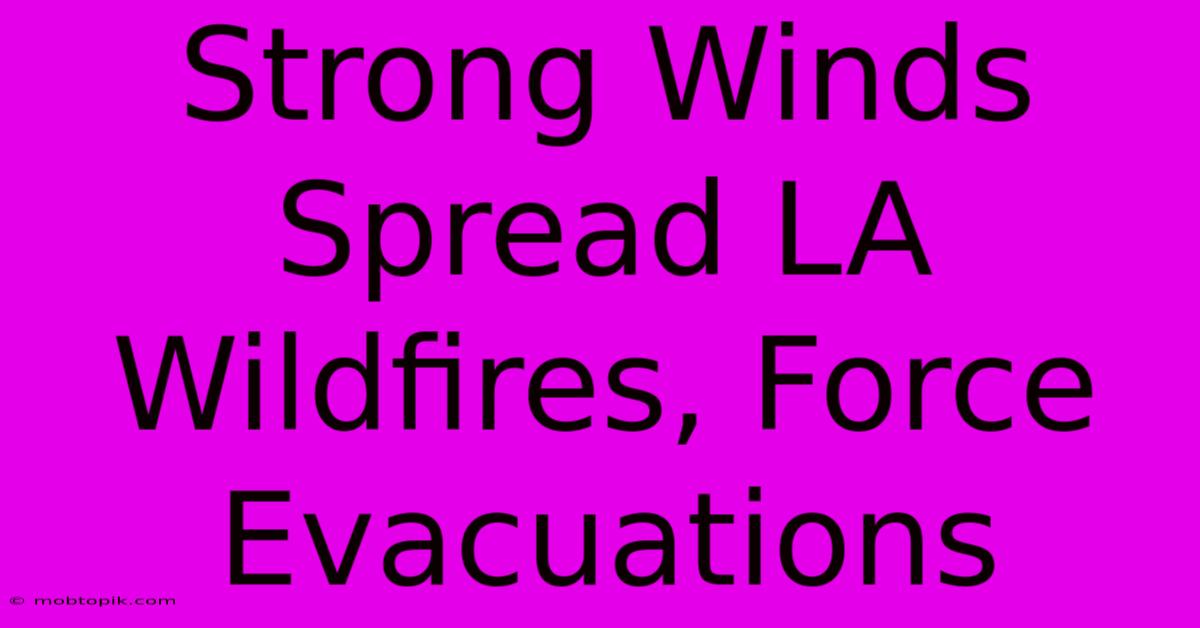Strong Winds Spread LA Wildfires, Force Evacuations

Discover more detailed and exciting information on our website. Click the link below to start your adventure: Visit Best Website mobtopik.com. Don't miss out!
Table of Contents
Strong Winds Spread LA Wildfires, Force Evacuations
Southern California is once again battling the destructive force of wildfires, fueled by strong Santa Ana winds and dry brush. The blazes, which have erupted across Los Angeles County and surrounding areas, have forced widespread evacuations, destroyed homes, and prompted a state of emergency. This article will delve into the details of these devastating fires, exploring their causes, impact, and the ongoing efforts to contain them.
The Role of Santa Ana Winds
The Santa Ana winds, infamous for their dry and powerful gusts, are a major contributing factor to the rapid spread of these wildfires. These winds originate in the high-pressure systems over the Great Basin and descend into Southern California, compressing and heating as they move through mountain passes. This process creates extremely low humidity and high wind speeds, acting like a bellows on already ignited brush and dry vegetation. The winds not only accelerate the flames but also make fire-fighting efforts significantly more challenging, as they can easily push flames across containment lines and ignite new areas. Understanding the meteorological conditions driving these fires is crucial for predicting their behavior and implementing effective response strategies.
Predicting and Monitoring Santa Ana Wind Events
Meteorological agencies continuously monitor atmospheric conditions to predict the onset and intensity of Santa Ana winds. Sophisticated weather models and real-time data analysis help forecasters issue timely warnings, providing crucial time for residents to prepare and evacuate. However, the unpredictable nature of these winds, combined with the highly flammable conditions, creates a complex challenge for accurate prediction and effective response planning. Improved forecasting accuracy remains a critical area of research and development in wildfire management.
Impact on Communities and Infrastructure
The wildfires have had a devastating impact on communities across Los Angeles County. Thousands of residents have been forced to evacuate their homes, leaving behind their belongings and facing uncertainty about the future of their properties. Many have lost their homes entirely, while others are anxiously awaiting news of the fate of their residences. The fires have also caused significant damage to infrastructure, including roads, power lines, and communication networks. The economic cost of these fires is substantial, encompassing property damage, emergency response, and long-term recovery efforts. The psychological toll on affected residents and emergency responders should not be overlooked.
Evacuation Procedures and Community Support
Efficient and effective evacuation procedures are vital during wildfire emergencies. Clear communication channels, well-defined evacuation routes, and community-based preparedness plans are essential for minimizing casualties and ensuring the safety of residents. Support networks, including temporary shelters, food banks, and counseling services, play a critical role in providing immediate assistance to displaced individuals and families. Community resilience and mutual support are key elements in recovery efforts following devastating wildfire events.
Firefighting Efforts and Containment Strategies
Firefighters from across the state and even out of state are battling the intense blazes, utilizing a range of resources and techniques. Air tankers drop fire retardant to slow the spread of flames, while ground crews work tirelessly to establish containment lines and protect structures. However, the challenging terrain, unpredictable winds, and extreme fire behavior make containment a slow and difficult process. Coordination and collaboration between various agencies and personnel are crucial for effective fire suppression.
Technological Advancements in Wildfire Management
Technological advancements are transforming wildfire management strategies. Sophisticated mapping systems, satellite imagery, and real-time data analysis aid in monitoring fire behavior, assessing risks, and directing firefighting resources efficiently. Drones are being increasingly used for surveillance, fire mapping, and delivering supplies to remote areas. Investing in and implementing advanced technologies is vital for enhancing wildfire response capabilities.
Long-Term Impacts and Mitigation Strategies
The long-term impacts of these wildfires extend beyond the immediate damage. Air quality is severely compromised, posing risks to public health. The loss of vegetation can lead to soil erosion and increased risk of flooding. Wildlife habitats are devastated, affecting biodiversity and ecosystem services. Effective long-term recovery plans must address these environmental and social consequences.
Prevention and Mitigation Efforts
Preventing wildfires requires a multi-pronged approach. This includes implementing stricter building codes in fire-prone areas, promoting responsible land management practices, creating defensible spaces around homes, and educating the public about wildfire risks. Investing in fuel management projects, such as controlled burns and brush clearing, can significantly reduce the intensity and spread of future wildfires. A comprehensive strategy that encompasses prevention, preparedness, and recovery is essential for mitigating the devastating impact of wildfires.
Conclusion: The Ongoing Battle Against Wildfires
The strong winds spreading LA wildfires highlight the urgent need for improved preparedness, response strategies, and long-term mitigation efforts. While firefighters and emergency personnel are bravely battling these blazes, the underlying factors driving the increasing frequency and intensity of wildfires necessitate a broader societal response. This includes investing in advanced technologies, fostering community resilience, and implementing comprehensive strategies to reduce the risk of future wildfire disasters. The ongoing battle against wildfires requires a concerted effort from all levels of government, communities, and individuals. The future of California's landscape and the safety of its residents depend on it.

Thank you for visiting our website wich cover about Strong Winds Spread LA Wildfires, Force Evacuations. We hope the information provided has been useful to you. Feel free to contact us if you have any questions or need further assistance. See you next time and dont miss to bookmark.
Also read the following articles
| Article Title | Date |
|---|---|
| Arsenal Vs Newcastle Live Stream Carabao Cup | Jan 08, 2025 |
| Arsenal Vs Newcastle Carabao Cup Score | Jan 08, 2025 |
| Live Arsenal Vs Newcastle Carabao Cup Match | Jan 08, 2025 |
| Palisades Fire Evacuation Orders And Alerts | Jan 08, 2025 |
| Arsenal Newcastle Carabao Cup Live Score | Jan 08, 2025 |
